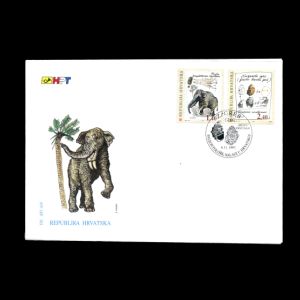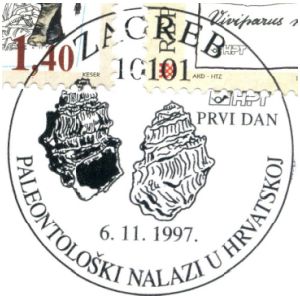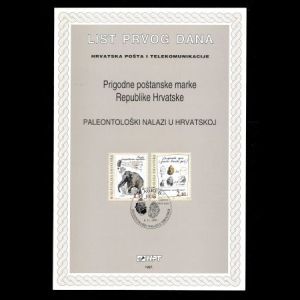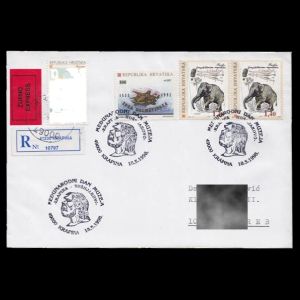Croatia 1997
"Paleontological Finds in Croatia"
| Issue Date |
06.11.1997 |
| ID |
Michel: 436-437,
Scott: 346-347,
Stanley Gibbons: 514-515,
Yvert et Tellier: 411-412,
Category: pR
|
| Design |
Painter: Zlatko Keser, Academy of Fine Arts, Zagreb |
| Stamps in set |
2 |
| Value |
1.40 - Prehistoric Elephant (Gomphotherium angustidents)
2.40 - Novska Water Snail (Viviparus novskaensis)
|
| Emission/Type |
commemorative |
| Places of issue |
Zagreb |
| Size (width x height) |
29,82mm x 35,5mm |
| Layout |
Sheet of 20 stamps |
| Products |
FDC x1 |
| Paper |
white 102g, gummed |
| Perforation |
14 |
| Print Technique |
Multicolor offset |
| Printed by |
Agencija Za Komercijalnu Djelatnost |
| Quantity |
350.000 sets |
| Issuing Authority |
Croatian Post and Telecommunications |
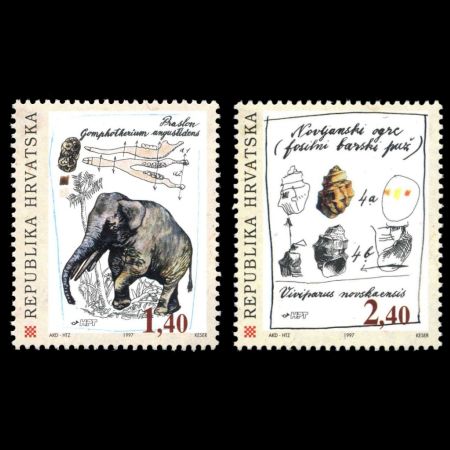
On November 6
th 1997, Croatian Post and Telecommunications issued the set of
two stamps "Paleontological Finds in
Croatia".
The following is translation of a text,
published by Croatian Post in 1997.
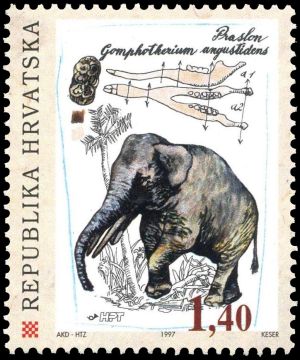 |
|
Prehistoric elephant Gomphotherium angustidents on stamp of Croatia 1997,
MiNr.: 436, Scott: 346.
|
In the mine of bentonites, ancient sediments of volcanic ash, in the marshes of prehistoric times
from the Pannonian territories, miners have recently found, from the year 1994 to 1996, singular
bones of large mammals.
Paleontologists have identified these exceptional fossils and they have attributed
them to the remains of the fossils of the species from long-extinct elephants, to present-day suborder Proboscideans,
to the species Prodeinotherium bavarieum (H.v.MEYER) and Gomphotherium angustidens (CUVIER).
The remains of these elephants (many teeth, tusks, parts of skull and skeleton),
come from the subsurface below the village of Gornja Jelenska, near the village of Popovaca
in the Moslavina region.
Their age, defined for the moment using geological and paleontological tests, is 18 million years old.
This was the Lower Miocene age when the territories of today's northern Croatia were
covered with vast woods, meadows and marshes with tropical or intertropical vegetation.
The first prehistoric elephants appeared on African territory 40 million years ago.
The continents, the vast dry lands, the old floating southern continents, joined the territory of today's
Europe and Asia at the Arabian Peninsula, so that the old African elephants left their country to settle
on the northern continents.
The prehistoric elephants found in Moslavina, belonged to the group of large mammals
the oldest in Europe and Asia and they are certainly the most valuable paleontological find in Croatia.
M.Sc. Jakov Hadovöic, museum advisor Geological-paleontological division
of the Croatian Natural History Museum.
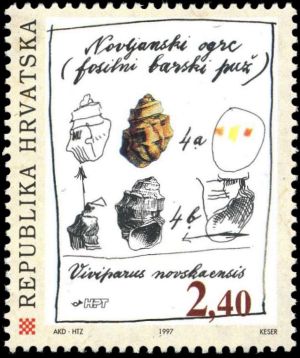 |
|
Fossil of Viviparus novskaensis on stamp of Croatia 1997,
MiNr.: 437, Scott: 347,
|
Viviparus (old name Paludina) is a species of freshwater snail that dates back to the Chalk Era (100 million years ago).
They were most prevalent during the Pliocene era (5 to 2 million years ago), the time when they inhabited
the vast but shallow freshwater lakes, which remained as a result of the drying up and softening of the "Sea Pannonian".
Today they live in some rivers and lakes of Europe and their Croatian name is ogre.
The species of Viviparus is important because the Viennese paleontologist M.NEUMAYR published, in 1875, his work on the evolution
of this species.
With the Viennese geologist C.M.PAUL he studied the paludal (marsh) deposits of Slavonia.
During his research he noticed that the shapes were linked together and he could only with difficulty isolate the different species.
The reason was: the shells changed over the years, so that one species became another.
Thus in the oldest marsh lower layers, lived species with smooth shells (such as V. neumayn), while in the more recent
marsh upper strata were found the variously ornamented species, with rounded spiral shells with small nodes (such as V.hoemesi and V.stun).
This is how NEUMAYR defines the evolutionary or phylogenetic series of the species Viviparus, known in world paleontology.
In the years to come (in 1886), this evolutionary series was developed and completed by K.A.PENECKE, who had described a new
species V.novskaensis.
Viviparus novskaensis (novljanski ogre) is an extinct fossil species that we most often encounter in the layers of marsh
around the town of Novska.
Its name, this species owes it to the paleontologist K.A.PENECKE who described it in 1886.
The description was:
"A conical oval shell, with thick walls, made of 5 envelopes, the last of which comprises almost 2/3 of
the height of the shell.
The envelopes are placed gradually and each has two edges which end in irregular nodes... "
This same author gave the name of Novska, to a species of the fossil lamellibranchs of the malaria layers, Unia novskaensis.
The German paleontologist W.Wenz gave the name Novska to a suborder of freshwater snails such Melanopsis constricta novskaensis.
Few are the localities which have given their name to three taxa, as is Novska's case.
This fact shows us that a rather specific form was developed in Novska and its surroundings and that this form was distinguished
by its particularity in the whole of the fauna of Slavonia in the so rich era of the Pliocene.
M.Sc. Zlata .Juriéic-Polsak, museum adviser Geological-paleontological
division of the Croatian Natural History Museum.
Products and associated philatelic items
References:
- Technical details and short description of the stamps:
Croatian Post (the article isn't available anymore),
Colnect,
stampedout,
the inside text of here (in Croatian and French).
Acknowledgement:
Many thanks to Dr. Peter Voice, PhD Department of Geological and Environmental Sciences,
Western Michigan University, USA, for review draft page of the article.



